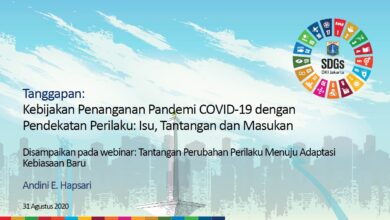
Jakarta is a concrete jungle with almost 90 percent of its area built over, leaving only 10 percent for green space, a leading cause of flooding in the capital. While the blame is often put on skyscrapers and business districts, residential areas are not entirely free from the problem.
As a result of limited space and soaring land prices in Jakarta, many residents try to make the most of their houses by turning their small gardens into a roofed parking space, terrace or an additional room.
While it provides an affordable way for people to expand their home, concreting over green space is bad for the environment. It prevents rainfall from being absorbed and thus increases the chance of water runoff during the rainy season.
One resident who has converted her green space is Mia Yunita, 58, who lives in Bintaro, Pesanggrahan, South Jakarta, in a house she bought from her aunt in 2009.
The house, which sits on a 487 square-meter plot of land used to have open green space, but now almost all of the open area has been covered by paving blocks.
Living with 12 people all of whom are women, Mia decided to lay the paving blocks to ease home maintenance.
“I have three dogs, and the grass used to grow too tall in two weeks and I had to call a gardener to cut the grass,” Mia said, adding that some gardeners were reluctant to take on the work because they were afraid of the dogs.
As the paving is not cemented in place, the open space can still absorb rainfall, although at a limited rate.
Luckily, Mia’s residential area has a good water-absorption capacity, and it was largely unaffected during the heavy rainfall that caused flooding in the city over the New Year.
The 2007 Spatial Plan Law regulates that a city should dedicate 30 percent of its area as green space, 20 percent of which is supplied by the local administration and the remaining 10 percent by private entities.
The Jakarta administration, through its bylaw No. 1/2014 on spatial planning and zoning, stipulates that a building should allocate around 30 percent of its total ground area for open space to support water retention. The percentage may vary according to the building type.
Any building project must meet the requirement in order to secure a building permit (IMB) to start the construction.
Failure to keep the required open space is considered a violation of the city’s spatial plan, but enforcement is rare, especially in residential areas where residents often renovate or expand their houses without updating their IMB.
Aryanindita, 31, is among the city residents who understand the importance of maintaining green space.
She lives with her parents and younger brother in a 140 sq.m house in Srengseng, Kembangan, West Jakarta, where the family tends a 20 sq.m garden and has installed a biopore hole.
“It [the biopore hole] is usually covered with dirt, so we have to regularly open it once every few months,” Aryanindita said.
Her neighborhood was also free from the New Year flooding, with the rain only puddling in the street in front of their home for a while before receding.
Jakarta Spatial Planning Agency head Heru Hermawanto acknowledged many citizens’ tendency to convert their green areas into living space given the limited space and the astronomical price of land in Jakarta.
However, he noted that there was still a way to slow down water runoff despite limited open space. Homeowners, Heru suggested, could install waste water piping systems that promote water absorption, instead of channeling waste water directly into the gutters.
“Water retention doesn’t have to be on open space, as long as it’s managed well,” Heru said.
Indonesian Architecture Association (IAI) chairman Ahmad Djaharu encouraged homeowners to take measures to increase water absorption rates in their areas. Ahmad, however, noted that such individual initiatives should be supported by a good drainage system throughout the city.
“It is humans’ ecological responsibility to balance groundwater supply. If we constantly use it, it will be exhausted, […] people should be expected to return water to the ground if they have the chance to do so,” Djaharu said.
Meanwhile, Elisa Sutanudjaja, executive director of the Rujak Center for Urban Studies, said that private entities, including residential areas, should maintain their green space as stipulated in their building coefficient (KDB) and green space coefficient (KDH) documents.
“But if the Jakarta administration wants a quick win [in recovering green space], it should focus on the large entities with areas of over 5,000 sq.m including housing complexes managed by [major] land developers,” Elisa said.
She added that such major entities tended to have more complete documentation, a smaller number of parties involved and have a bigger responsibility than individual householders.
Artikel ini telah tayang di thejakartapost.com dengan judul “Despite regulations, Jakarta homeowners concrete over green spaces”, https://www.thejakartapost.com/news/2020/01/14/despite-regulations-jakarta-homeowners-concrete-over-green-spaces.html
Penulis : A. Muh. Ibnu Aqil
Foto Cover: In the same boat: Soldiers help evacuate residents from the flood-hit Bojong Indah residential area in West Jakarta in early January. (JP/Donny Fernando)



